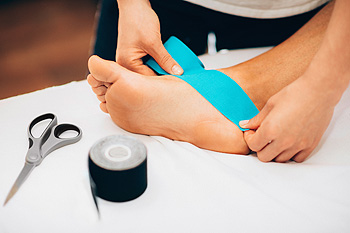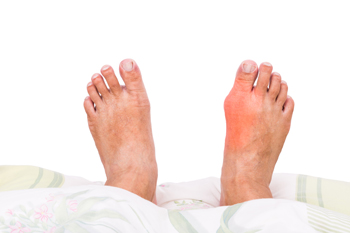Items filtered by date: July 2019
How to Choose High Heels
 The benefits of wearing high heels can include the legs appearing longer and slimmer. It may come with a price of having foot pain, and this can be the result of the shoes having inadequate room for the toes to move freely in. If the desire is strong to wear high heels, there are a variety of methods that can be implemented which may diminish foot pain. These can include getting your feet properly measured to determine the correct shoe size, keeping the heels about two inches high, and making sure there is enough cushioning and support in the shoe. Additionally, it may be beneficial to choose shoes that have rounded toes, as this can be helpful in preventing bunions, and other foot conditions. If you would like additional information on how high heels can affect your feet, please consult with a podiatrist.
The benefits of wearing high heels can include the legs appearing longer and slimmer. It may come with a price of having foot pain, and this can be the result of the shoes having inadequate room for the toes to move freely in. If the desire is strong to wear high heels, there are a variety of methods that can be implemented which may diminish foot pain. These can include getting your feet properly measured to determine the correct shoe size, keeping the heels about two inches high, and making sure there is enough cushioning and support in the shoe. Additionally, it may be beneficial to choose shoes that have rounded toes, as this can be helpful in preventing bunions, and other foot conditions. If you would like additional information on how high heels can affect your feet, please consult with a podiatrist.
High heels have a history of causing foot and ankle problems. If you have any concerns about your feet or ankles, contact Dr. John P. Beaupied from Palos Podiatry. Our doctor can provide the care you need to keep you pain-free and on your feet.
Effects of High Heels on the Feet
High heels are popular shoes among women because of their many styles and societal appeal. Despite this, high heels can still cause many health problems if worn too frequently.
Which Parts of My Body Will Be Affected by High Heels?
- Ankle Joints
- Achilles Tendon – May shorten and stiffen with prolonged wear
- Balls of the Feet
- Knees – Heels cause the knees to bend constantly, creating stress on them
- Back – They decrease the spine’s ability to absorb shock, which may lead to back pain. The vertebrae of the lower back may compress.
What Kinds of Foot Problems Can Develop from Wearing High Heels?
- Corns
- Calluses
- Hammertoe
- Bunions
- Morton’s Neuroma
- Plantar Fasciitis
How Can I Still Wear High Heels and Maintain Foot Health?
If you want to wear high heeled shoes, make sure that you are not wearing them every day, as this will help prevent long term physical problems. Try wearing thicker heels as opposed to stilettos to distribute weight more evenly across the feet. Always make sure you are wearing the proper shoes for the right occasion, such as sneakers for exercising. If you walk to work, try carrying your heels with you and changing into them once you arrive at work. Adding inserts to your heels can help cushion your feet and absorb shock. Full foot inserts or metatarsal pads are available.
If you have any questions please feel free to contact our office located in Palos Heights, IL . We offer the newest diagnostic and treatment technologies for all your foot and ankle needs.
Possible Causes of Gout
The symptoms that many patients experience with the medical condition that is known as gout often include severe pain and discomfort, in addition to swelling on and around the big toe. The pain can be so disabling it can limit the ability to walk and to perform daily activities. This condition is caused by an excess of uric acid that is in the bloodstream, and can develop from eating foods that have large amounts of purines. These can include shellfish, red meat, alcohol, and drinks that are high in fructose. If certain medications are taken which can consist of water pills and low dose aspirin, it may lead to the development of gout. There are measures that can be implemented which may help to avoid gout attacks. These include eating limited amounts of red meat, and reducing alcohol intake. If you have developed gout, it is suggested that you consult with a podiatrist who can perform an accurate diagnosis and begin the correct treatment.
Gout is a foot condition that requires certain treatment and care. If you are seeking treatment, contact Dr. John P. Beaupied from Palos Podiatry. Our doctor will treat your foot and ankle needs.
What Is Gout?
Gout is a type of arthritis caused by a buildup of uric acid in the bloodstream. It often develops in the foot, especially the big toe area, although it can manifest in other parts of the body as well. Gout can make walking and standing very painful and is especially common in diabetics and the obese.
People typically get gout because of a poor diet. Genetic predisposition is also a factor. The children of parents who have had gout frequently have a chance of developing it themselves.
Gout can easily be identified by redness and inflammation of the big toe and the surrounding areas of the foot. Other symptoms include extreme fatigue, joint pain, and running high fevers. Sometimes corticosteroid drugs can be prescribed to treat gout, but the best way to combat this disease is to get more exercise and eat a better diet.
If you have any questions please feel free to contact our office located in Palos Heights, IL . We offer the newest diagnostic and treatment technologies for all your foot and ankle needs.
Gout Pain Can Be Managed
Tarsal Tunnel Syndrome Is Caused by Nerve Damage
 The medical condition that is referred to as tarsal tunnel syndrome, or TTS, can cause pain and discomfort on the inside of the ankle. It often occurs as a result of nerve damage, which may lead to inflammation. Patients who run or exercise for extended periods of time may gradually experience this type of nerve damage, or it may come from enduring a traumatic injury. Mild relief may be felt by gently stretching the surrounding muscles and tendons, in addition to resting and elevating the affected ankle. This may help to diminish a portion of the swelling. In severe cases, taping the ankle or wearing a brace may provide adequate support as the ankle heals. If you feel you have this condition, it is suggested to consult with a podiatrist who can offer the correct treatment options for you.
The medical condition that is referred to as tarsal tunnel syndrome, or TTS, can cause pain and discomfort on the inside of the ankle. It often occurs as a result of nerve damage, which may lead to inflammation. Patients who run or exercise for extended periods of time may gradually experience this type of nerve damage, or it may come from enduring a traumatic injury. Mild relief may be felt by gently stretching the surrounding muscles and tendons, in addition to resting and elevating the affected ankle. This may help to diminish a portion of the swelling. In severe cases, taping the ankle or wearing a brace may provide adequate support as the ankle heals. If you feel you have this condition, it is suggested to consult with a podiatrist who can offer the correct treatment options for you.
Tarsal tunnel syndrome can be very uncomfortable to live with. If you are experiencing tarsal tunnel syndrome, contact Dr. John P. Beaupied of Palos Podiatry. Our doctor can provide the care you need to keep you pain-free and on your feet.
Tarsal Tunnel Syndrome
Tarsal tunnel syndrome, which can also be called tibial nerve dysfunction, is an uncommon condition of misfiring peripheral nerves in the foot. The tibial nerve is the peripheral nerve in the leg responsible for sensation and movement of the foot and calf muscles. In tarsal tunnel syndrome, the tibial nerve is damaged, causing problems with movement and feeling in the foot of the affected leg.
Common Cause of Tarsal Tunnel Syndrome
- Involves pressure or an injury, direct pressure on the tibial nerve for an extended period of time, sometimes caused by other body structures close by or near the knee.
- Diseases that damage nerves, including diabetes, may cause tarsal tunnel syndrome.
- At times, tarsal tunnel syndrome can appear without an obvious cause in some cases.
The Effects of Tarsal Tunnel Syndrome
- Different sensations, an afflicted person may experience pain, tingling, burning or other unusual sensations in the foot of the affected leg.
- The foot muscles, toes and ankle become weaker, and curling your toes or flexing your foot can become difficult.
- If condition worsens, infections and ulcers may develop on the foot that is experiencing the syndrome.
A physical exam of the leg can help identify the presence of tarsal tunnel syndrome. Medical tests, such as a nerve biopsy, are also used to diagnose the condition. Patients may receive physical therapy and prescriptive medication. In extreme cases, some may require surgery.
If you have any questions please feel free to contact our office located in Palos Heights, IL . We offer the newest diagnostic and treatment technologies for all your foot and ankle needs.
Different Types of Arthritis in the Feet
 The feet are comprised of numerous bones, joints, and tendons. Patients who are afflicted with arthritis in the feet may notice changes that occur in the arch. Osteoarthritis can affect the joints in the big toe, and the range of motion may become limited. Other symptoms can often include the bones becoming bigger, and a bunion may form on the outside of the big toe. Research has indicated there are several forms of inflammatory arthritis. These include reactive arthritis, gout, and psoriatic arthritis. The former typically affects the heel and ankle. Symptoms of gout often include severe pain and discomfort, and typically affects the big toe. The latter type of arthritis causes dactylitis, which is defined as pain and swelling. If you are suffering from any type of arthritis in the feet, it is suggested to schedule a consultation with a podiatrist who can properly treat this condition.
The feet are comprised of numerous bones, joints, and tendons. Patients who are afflicted with arthritis in the feet may notice changes that occur in the arch. Osteoarthritis can affect the joints in the big toe, and the range of motion may become limited. Other symptoms can often include the bones becoming bigger, and a bunion may form on the outside of the big toe. Research has indicated there are several forms of inflammatory arthritis. These include reactive arthritis, gout, and psoriatic arthritis. The former typically affects the heel and ankle. Symptoms of gout often include severe pain and discomfort, and typically affects the big toe. The latter type of arthritis causes dactylitis, which is defined as pain and swelling. If you are suffering from any type of arthritis in the feet, it is suggested to schedule a consultation with a podiatrist who can properly treat this condition.
Arthritis can be a difficult condition to live with. If you are seeking treatment, contact Dr. John P. Beaupied from Palos Podiatry. Our doctor can provide the care you need to keep you pain-free and on your feet.
Arthritic Foot Care
Arthritis is a joint disorder that involves the inflammation of different joints in your body, such as those in your feet. Arthritis is often caused by a degenerative joint disease and causes mild to severe pain in all affected areas. In addition to this, swelling and stiffness in the affected joints can also be a common symptom of arthritis.
In many cases, wearing ill-fitting shoes can worsen the effects and pain of arthritis. Wearing shoes that have a lower heel and extra room can help your feet feel more comfortable. In cases of rheumatoid arthritis, the arch in your foot may become problematic. Buying shoes with proper arch support that contour to your feet can help immensely.
Alleviating Arthritic Pain
- Exercises that stretch the foot can prevent further pain and injury and increase mobility
- Most of the pain can be alleviated with anti-inflammatory drugs, heat, and topical medications
- Massages can help temporarily alleviate pain.
It is best to see your doctor for the treatment that is right for your needs and symptoms. Conditions vary, and a podiatrist can help you determine the right method of care for your feet.
If you have any questions, please feel free to contact our office located in Palos Heights, IL . We offer the newest diagnostic tools and technology to treat your foot and ankle needs.
How to Treat Wounds on the Feet
 The feet are susceptible to cuts that may penetrate the skin. Minor wounds can be treated with bandages or skin glue, and the healing process will accelerate if the cuts are kept covered and dry. If you have stepped on glass or rocks, an X-ray may be necessary to ensure there is no debris left in the foot. For serious wounds, it is beneficial to keep weight off of the foot as much as possible, as this can help in giving the foot a chance to heal. If the wound is bleeding, it is helpful to apply direct pressure. If this fails to work, it is wise to seek medical attention. Additionally, an infection may be present which is often accompanied by a fever. For wounds on the feet, it is suggested to seek the counsel of a podiatrist who can guide you towards proper treatment.
The feet are susceptible to cuts that may penetrate the skin. Minor wounds can be treated with bandages or skin glue, and the healing process will accelerate if the cuts are kept covered and dry. If you have stepped on glass or rocks, an X-ray may be necessary to ensure there is no debris left in the foot. For serious wounds, it is beneficial to keep weight off of the foot as much as possible, as this can help in giving the foot a chance to heal. If the wound is bleeding, it is helpful to apply direct pressure. If this fails to work, it is wise to seek medical attention. Additionally, an infection may be present which is often accompanied by a fever. For wounds on the feet, it is suggested to seek the counsel of a podiatrist who can guide you towards proper treatment.
Wound care is an important part in dealing with diabetes. If you have diabetes and a foot wound or would like more information about wound care for diabetics, consult with Dr. John P. Beaupied from Palos Podiatry. Our doctor will assess your condition and provide you with quality foot and ankle treatment.
What Is Wound Care?
Wound care is the practice of taking proper care of a wound. This can range from the smallest to the largest of wounds. While everyone can benefit from proper wound care, it is much more important for diabetics. Diabetics often suffer from poor blood circulation which causes wounds to heal much slower than they would in a non-diabetic.
What Is the Importance of Wound Care?
While it may not seem apparent with small ulcers on the foot, for diabetics, any size ulcer can become infected. Diabetics often also suffer from neuropathy, or nerve loss. This means they might not even feel when they have an ulcer on their foot. If the wound becomes severely infected, amputation may be necessary. Therefore, it is of the upmost importance to properly care for any and all foot wounds.
How to Care for Wounds
The best way to care for foot wounds is to prevent them. For diabetics, this means daily inspections of the feet for any signs of abnormalities or ulcers. It is also recommended to see a podiatrist several times a year for a foot inspection. If you do have an ulcer, run the wound under water to clear dirt from the wound; then apply antibiotic ointment to the wound and cover with a bandage. Bandages should be changed daily and keeping pressure off the wound is smart. It is advised to see a podiatrist, who can keep an eye on it.
If you have any questions, please feel free to contact our office located in Palos Heights, IL . We offer the newest diagnostic and treatment technologies for all your foot care needs.





